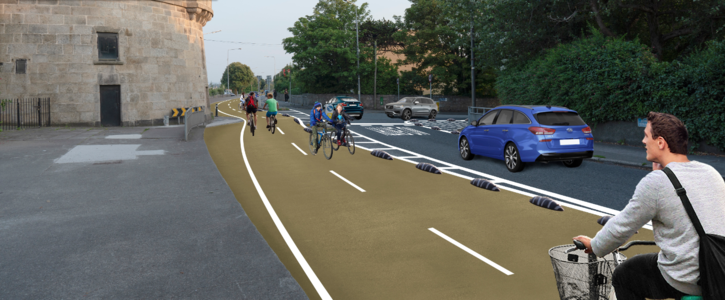1,000 signatures reached
To: Dublin City Council
Trial a Strand Road cycle path for 12 months

Dublin City Council won its legal case after years of Court battles. We cannot listen to those who are trying to block quick action on climate change, road safety, and increasing mobility options.
The undersigned are calling on Dublin City Council to start a 12-month trial of a two-way cycle path on Beach Road, Strand Road and onto the Merrion Road to connect to Dún Laoghaire–Rathdown County Council’s Coastal Mobility Route (CMR).
A trial will show if the negatives override the benefits. But the council should try to address concerns by carrying out close monitoring of traffic, taking any necessary measures to limit rat-running once Strand Road and Beach Road are made one-way, monitor and take steps to ensure that bus priority on the Merrion Road is not affected, and using the two-way cycle path to maintain north-south accessibility for emergency services on Strand Road and Beach Road (as is done in Paris, London and on the CMR).
This project addresses transport mobility, climate action, road safety and a range of health issues, and has side benefits such as leisure and tourism. That's why the call for a trial and this petition are supported by:
This project addresses transport mobility, climate action, road safety and a range of health issues, and has side benefits such as leisure and tourism. That's why the call for a trial and this petition are supported by:
- A Playful City
- Climate and Health Alliance
- Cycling Without Age
- DLR Living Streets
- Dublin Commuter Coalition
- Dublin Cycling Campaign and the Irish Cycling Campaign
- Friends of the Earth
- I Bike Dublin
- Irish Doctors for the Environment
- IrishCycle.com
- Irish Heart Foundation
- Jesuit Centre for Faith and Justice
- Strand and Beach Road Residents
- The Bike Hub
- And more TBC
Why is this important?
The only thing that will block the trial now is if there is not enough leadership. So, as well as signing this petition, please contact your local Dublin councillors to ask them to support this project as it has city-wide benefits. A list of councillors to contact can be found on a page at dublincity.ie.
This is a council issue, but TDs have involved themselves, so, if you have the time, please also contact your local TDs, especially Dublin Bay South TDs.
This is a council issue, but TDs have involved themselves, so, if you have the time, please also contact your local TDs, especially Dublin Bay South TDs.
Some background: Over 4 years ago, the High Court blocked a trial of the Strand Road cycle path. The case had a chilling effect on the roll-out of safer and more climate-friendly streets. But last month, the Court of Appeal found that the High Court judgment was flawed on all substantive points.
However, despite the council's success after a long legal battle, the public funding used to rightly defend their position, and strong reasoning for proceeding with the trial, some local Sandymount groups and politicians are still attempting to block this city-wide issue.
The following are reasons why the project should be trialled:
(1) This is a city-wide issue
A ~3.5km cycle path on Beach Road, Strand Road and onto the Merrion Road will provide the first such cycle route crossing administrative borders in the south side of the city. This is not only a local Sandymount issue. It will both help local children cycle to school and allow commuters and others to go greater distances.
Combined with the existing coastal route built by DLRCC, the route would total 10km with connections to other routes at both ends. It won’t be all perfect at first, but it will be a huge leap forward in providing a relatively continuous, safe and attractive route.
The evidence is clear that cycle paths encourage more people to cycle. A 10km route does not mean that everybody is going to start cycling that distance. Some will, while others will use different parts of the route along the way, with links to other routes.
The evidence is clear that cycle paths encourage more people to cycle. A 10km route does not mean that everybody is going to start cycling that distance. Some will, while others will use different parts of the route along the way, with links to other routes.
(2) Strongly vindicated after a long legal battle
Dublin City Council has been strongly vindicated. The claims that these relatively minor interventions in terms of the level of construction would need planning and detailed environmental assessment have been blown out of the water by the Court of Appeal.
Despite claims from some objectors, the ruling was a stinging defeat, with all substantive points made overturned.
After such a clear decision following the spending of a significant amount of public money to defend the case, there is a moral duty for Dublin City Council to proceed with the trial.
After such a clear decision following the spending of a significant amount of public money to defend the case, there is a moral duty for Dublin City Council to proceed with the trial.
The now-overturned High Court ruling also had huge cost implications and caused a slowdown in project delivery.
(3) If the sky falls in, it can be reversed
Because the trial involves reallocating existing road space, it can be trialled rather quickly and without too much expense. And, if the sky falls in, it can be reversed.
We have decades of evidence and examples showing that traffic does not act the way most people think it does. The Irish Water’s works in late 2022 and early 2023, which made Strand Road one-way for months, provide a good indication that the sky will not fall in — we first heard from supportive residents saying so and then from data confirming this.
Some claim that the road needs to be kept two-way because of new housing around the Glass Bottle, but continuing the status quo will just mean the new residents adding to gridlock. A shift in approach is needed.
Some claim that the road needs to be kept two-way because of new housing around the Glass Bottle, but continuing the status quo will just mean the new residents adding to gridlock. A shift in approach is needed.
With the road made one-way and the cycle route in place, it will have the added positive effect of providing many people with an alternative transport option and allow for wider monitoring to see if making the road one-way is overall beneficial.
(4) A route “on the green areas” could take 15+ years
The cycle route cannot be easily built off-road “in the park” on green areas. People claiming an off-road option is a real alternative to a project which can be trialled within weeks are not dealing with the facts.
The green areas at Sandymount Promenade are not continuous. The gaps are effectively part of Dublin Bay, which is a protected area and an UNESCO Biosphere. When the sections of the bay were filled in, EU-level environmental protections were not in place.
This is also not just something abstract. Outside the wall on Strand Road are rocks that serve as nesting areas for birds and other habitats. Ireland generally lags behind in its protection of natural areas.
The gap also includes a section where a path would have to be built between houses and the coast, potentially sparking stronger objections and further legal challenges. A suggestion of traffic lights to keep two-way traffic here is not viable, especially given the railway level crossing. Such an option would be more disruptive and a threat to safety at the level crossing.
The gap also includes a section where a path would have to be built between houses and the coast, potentially sparking stronger objections and further legal challenges. A suggestion of traffic lights to keep two-way traffic here is not viable, especially given the railway level crossing. Such an option would be more disruptive and a threat to safety at the level crossing.
(5) The need for climate action
Transport is Ireland’s second-largest sector for greenhouse gas emissions, but the binding emission reduction targets are likely not to be reached. The signees of this petition believe we should try harder.
Some people are dismissive of cycling provision as climate action, yet the IPCC has highlighted it as a means of ramping up action.
(6) We need to get moving, and wider health benefits are strong
Inactivity is another crisis we are facing, yet, it hardly ever gets the attention it deserves. Besides a set amount of people who are willing and able to go to the gym etc, research shows that most people can see better outcomes by integrating activity into their daily lives.
The health benefits of cycling as a mode of transport can also be wide-ranging, including a reduction in air pollution and a decrease in harmful noise levels.
(7) Cycle paths improve road safety for all road users
Another element of cycle routes is road safety — cycle paths are often traffic calming in their own right, and evidence shows that building cycle routes can make roads safer for all users.

